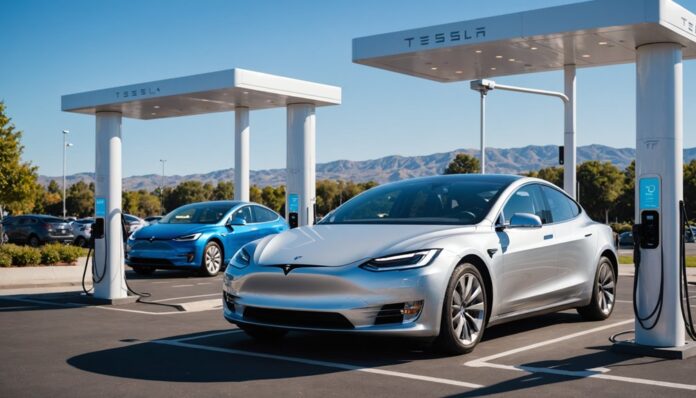The electric car charging environment in 2025 is marked by significant advancements in network coverage, pricing, and technology. Tesla’s Supercharger network dominates highways and urban centers, while regional players like ChargePoint and EVgo focus on underserved areas. As charging speeds improve and wireless technology emerges, a closer examination of these networks is necessary to understand their differences and determine which ones are best suited to meet the developing needs of electric vehicle owners.
Highlights
- Charging network coverage varies regionally, with some networks strong on the coasts and less dense in the Midwest.
- Pricing models include pay-as-you-go and subscription-based options, with membership benefits such as discounted rates and priority access.
- Charging speeds differ significantly, with some networks able to charge batteries to 80% in under 30 minutes.
- Contactless payments are widely accepted, and loyalty programs reward frequent users with discounts and incentives.
- Network reliability is crucial, with real-time monitoring and predictive analytics employed to minimize downtime and ensure charging stations are available.
Charging Network Coverage Comparison
How extensive is the coverage of various electric car charging networks? A comparison of charging networks reveals notable regional differences and coverage gaps.
While some networks boast extensive coverage along highways and in urban areas, others have more limited reach, leaving gaps in rural areas. For instance, ChargePoint and EVgo have a strong presence on the East and West Coasts, but coverage is less dense in the Midwest.
Meanwhile, Tesla’s Supercharger network provides thorough coverage across the country, but its exclusivity limits accessibility for non-Tesla owners.
Regional networks, such as Electrify America, focus on specific areas, filling in gaps left by larger networks. Understanding these coverage patterns can help electric vehicle owners and prospective buyers traverse the charging environment.
Pricing Plans and Membership Options
Beyond the physical reach of charging networks, another key consideration for electric vehicle owners is the cost of using these networks.
Pricing plans and membership options vary across providers, with some offering pay-as-you-go models and others requiring monthly or annual subscriptions. Membership benefits, such as discounted rates and priority access to charging stations, are also a key factor in determining the overall value proposition.
Pricing transparency is essential, as it enables drivers to make informed decisions about which network to use and when. The leading charging networks have moved towards providing clear and concise pricing information, making it easier for drivers to compare costs and choose the best option for their needs.
This transparency has also nurtured a sense of trust and loyalty among network members.
Charging Speeds and Technology
While the expansion of charging networks and the implementation of various pricing plans have remarkably enhanced the electric vehicle ownership experience, the efficiency of charging systems remains an essential consideration for drivers.
Charging speeds vary greatly across networks, with some offering fast charging capabilities that can replenish batteries to 80% in under 30 minutes. Others, however, may require several hours for a full charge.
The integration of wireless technology is also gaining traction, allowing vehicles to charge without physical connections. This innovation has the potential to further streamline the charging process.
As the demand for efficient charging solutions continues to grow, networks are investing in upgrades to support faster and more convenient charging options, enhancing the overall electric vehicle experience.
Payment Methods and Accepted Cards
The convenience of electric car charging is not only dependent on the speed and technology of the charging systems, but also on the payment methods and accepted cards offered by the networks.
Leading charging networks now offer contactless payments, allowing drivers to simply tap their credit or debit cards to initiate charging.
In addition to traditional payments, many networks have also implemented loyalty programs, rewarding frequent users with discounts and incentives.
These programs often include digital wallets and mobile apps, streamlining the payment process and providing a seamless charging experience.
The acceptance of various payment methods, including American Express, Visa, and Mastercard, further enhances the convenience of electric car charging, catering to the diverse needs of the growing electric vehicle community.
Network Reliability and Uptime
Reliability is an essential aspect of any electric car charging network, as downtime can leave drivers stranded and undermine confidence in the technology. A reliable network guarantees that charging stations are available and functioning when needed, providing drivers with a seamless and convenient experience.
Network performance and service availability are key indicators of a charging network’s reliability. Operators prioritize maintenance and repair to minimize downtime and optimize network performance. Some networks employ advanced technologies, such as real-time monitoring and predictive analytics, to identify and address potential issues before they occur.
User Reviews and Ratings
How do electric car charging networks measure up in the eyes of their users? To find out, one can look at user reviews and ratings. Many networks have dedicated review sections on their websites or mobile apps, where users can share their experiences and provide feedback.
Customer feedback can range from ease of use and charging speed to customer support and overall satisfaction. By analyzing user reviews, it becomes clear that some networks excel in certain areas, while others fall short.
For instance, some networks are praised for their seamless payment processes, while others are criticized for their lack of charging stations in rural areas. User experiences can serve as a significant resource for networks looking to improve their services and attract new customers.
Smartphone App Features and Functionality
While charging networks focus on expanding their physical infrastructure, their smartphone apps play an essential role in enhancing the overall user experience. A key aspect of these apps is their usability, allowing users to easily steer and locate charging stations.
Many apps offer location tracking, enabling users to find the nearest charging station and plan their route accordingly. Some apps also provide real-time updates on station availability and charging speed, helping users make informed decisions.
Additionally, apps often allow users to filter search results based on factors such as charging speed, price, and network affiliation. By prioritizing app usability and location tracking, charging networks can cultivate a sense of community and belonging among users, making electric vehicle ownership a more seamless and enjoyable experience.
Special Features and Incentives
As charging networks strive to differentiate themselves in a rapidly changing market, many incorporate special features and incentives to attract and retain users.
Incentive programs, such as rewards points, discounts, and free charging sessions, are designed to encourage loyalty and frequent use. Some networks offer unique features, like the ability to reserve charging stations in advance or access to exclusive charging corridors.
Others provide special benefits for members, including roadside assistance and dedicated customer support. These perks not only enhance the overall user experience but also promote a sense of belonging among network members.
Expansion Plans and Future Developments
With the electric vehicle market positioned for continued growth, charging networks are focusing on strategic expansion plans to meet increasing demand. Major players are investing heavily in infrastructure development, with a focus on high-power charging corridors and urban hubs.
Governments are also playing a vital role in shaping the future of electric vehicle charging through supportive policies and incentives. Infrastructure investment is being driven by government policies, such as tax credits and grants, which aim to accelerate the adoption of electric vehicles.
As the demand for electric vehicles continues to rise, charging networks are prioritizing scalability and flexibility in their expansion plans, ensuring a seamless charging experience for users. Strategic partnerships and collaborations are also on the horizon, further enhancing the charging ecosystem.
Conclusion
The electric car charging network scenery in 2025 is characterized by expanded coverage, diverse pricing models, and advancing technology. As the industry continues to evolve, consumer preferences will be shaped by factors such as network reliability, charging speeds, and user reviews. With ongoing innovations and expansion plans, charging networks will likely continue to improve, offering enhanced features and functionality to support the growing adoption of electric vehicles. Transparency and competition will drive the market forward.


